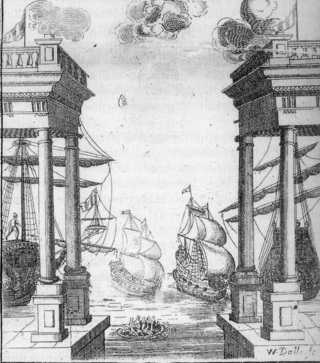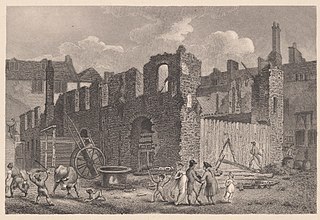Related Research Articles

1660 (MDCLX) was a leap year starting on Thursday of the Gregorian calendar and a leap year starting on Sunday of the Julian calendar, the 1660th year of the Common Era (CE) and Anno Domini (AD) designations, the 660th year of the 2nd millennium, the 60th year of the 17th century, and the 1st year of the 1660s decade. As of the start of 1660, the Gregorian calendar was 10 days ahead of the Julian calendar, which remained in localized use until 1923.

Sir William Davenant, also spelled D'Avenant, was an English poet and playwright. Along with Thomas Killigrew, Davenant was one of the rare figures in English Renaissance theatre whose career spanned both the Caroline and Restoration eras and who was active both before and after the English Civil War and during the Interregnum.
This article contains information about the literary events and publications of 1667.
This article contains information about the literary events and publications of 1666.
This article presents lists of the literary events and publications in 1661.

Edward Kynaston was an English actor, one of the last Restoration "boy players", young male actors who played women's roles.

Thomas Killigrew was an English dramatist and theatre manager. He was a witty, dissolute figure at the court of King Charles II of England.

The Restoration spectacular was a type of theatre production of the late 17th-century Restoration period, defined by the amount of money, time, sets, and performers it required to be produced. Productions attracted audiences with elaborate action, acrobatics, dance, costume, scenery, illusionistic painting, trapdoors, and fireworks. Although they were popular with contemporary audiences, spectaculars have earned a reputation from theatre historians as vulgar in contrast to the witty Restoration drama.
James Nokes was an English actor, whose laughter-arousing genius was attested by Cibber and other contemporaries.

Margaret Hughes, also Peg Hughes or Margaret Hewes, was an English actress who is often credited as the first professional actress on the English stage, as a result of her appearance on 8 December 1660. Hughes was the mistress of the English Civil War general Prince Rupert of the Rhine.

The Cockpit was a theatre in London, operating from 1616 to around 1665. It was the first theatre to be located near Drury Lane. After damage in 1617, it was named The Phoenix.


Gibbon's Tennis Court was a building off Vere Street and Clare Market, near Lincoln's Inn Fields in London, England. Originally built as a real tennis court, it was used as a playhouse from 1660 to 1663, shortly after the English Restoration. As a theatre, it has been variously called the "Theatre Royal, Vere Street", the "Vere Street Theatre", or simply "The Theatre". It was the first permanent home for Thomas Killigrew's King's Company and was the stage for some of the earliest appearances by professional actresses.
Events from the year 1660 in England. This is the year of Restoration.

The Duke's Company was a theatre company chartered by King Charles II at the start of the Restoration era, 1660. Sir William Davenant was manager of the company under the patronage of Prince James, Duke of York. During that period, theatres began to flourish again after they had been closed from the restrictions throughout the English Civil War and the Interregnum. The Duke's Company existed from 1660 to 1682, when it merged with the King's Company to form the United Company.
George Jolly, or Joliffe was an actor, an early actor-manager and a theatre impresario of the middle seventeenth century. He was "an experienced, courageous, and obstinate actor-manager" who proved a persistent rival for the main theatrical figures of Restoration theatre, Sir William Davenant and Thomas Killigrew.
Claricilla is a Caroline era stage play, a tragicomedy written by Thomas Killigrew. The drama was acted c. 1636 by Queen Henrietta's Men at the Cockpit Theatre, and first published in 1641. The play was an early success that helped to confirm Killigrew's choice of artistic career.
Mary Knep, also Knepp, Nepp, Knip, or Knipp, was an English actress and one of the first generation of female performers to appear on the public stage during the Restoration era.
Anne Marshall, also Mrs. Anne Quin, was a leading English actress of the Restoration era, one of the first generation of women performers to appear on the public stage in England.
Katherine Corey was an English actress of the Restoration era, one of the first generation of female performers to appear on the public stage in Britain. Corey played with the King's Company and the United Company, and had one of the longest careers of any actress in her generation. In "The humble petition of Katherine Corey", she stated that she "was the first and is the last of all the actresses that were constituted by King Charles the Second at His Restauration."
References
- ↑ Samuel Pepys (15 December 2000). The Diary of Samuel Pepys, Vol. 7: 1666. University of California Press. p. 13. ISBN 978-0-520-22698-2.
- ↑ Robert Chambers (1864). The Book of Days. A Miscellany of Popular Antiquties, in Connection with the Calendar. W.&R. Chambers. p. 720.
- ↑ Don-John Dugas (2006). Marketing the Bard: Shakespeare in Performance and Print, 1660-1740. University of Missouri Press. p. 103. ISBN 978-0-8262-6544-9.
- 1 2 3 Richard Bradford (13 May 2013). John Milton. Routledge. p. 47. ISBN 1-134-63270-3.
- ↑ Joseph Gardner Weber (1963). The Persuasive Art of Pascal's Lettres Provinciales: a Study of Satire, Irony, and Argumentation. University of Illinois.
- ↑ The Hutchinson Factfinder. Helicon. 1999. ISBN 1-85986-000-1.
- ↑ Howe, Elizabeth (1992). The First English Actresses: Women and Drama, 1660–1700 . Cambridge University Press. p. 24.
- ↑ Gilder, Rosamond (1931). Enter the Actress: The First Women in the Theatre. Boston: Houghton Mifflin. p. 166.
- ↑ Cain, Tom (2004). "Herrick, Robert (baptized 1591, d. 1674)". Oxford Dictionary of National Biography (Online ed.). Oxford University Press. doi:10.1093/ref:odnb/13092 . Retrieved 2014-03-25.(subscription or UK public library membership required)
- ↑ "Birgitte Thott | Gyldendal – Den Store Danske". denstoredanske.dk. Retrieved 2016-05-13.
- ↑ Royle, Trevor. "Aretina". The Mainstream Companion to Scottish Literature.
- ↑ Alexander Chalmers (1816). The General Biographical Dictionary. J. Nichols. pp. 293.
- ↑ Helen Ostovich; Elizabeth Sauer (2 August 2004). Reading Early Modern Women: An Anthology of Texts in Manuscript and Print, 1550-1700. Routledge. p. 339. ISBN 978-1-135-88769-8.
- ↑ Notes to the Diary of Samuel Pepys Retrieved 24 August 2016.
- ↑ Thomas Jones. "Lhuyd, Edward (1660-1709), botanist, geologist, antiquary and philologist". Dictionary of Welsh Biography . National Library of Wales . Retrieved 1 March 2019.
- ↑ Joseph Timothy Haydn (1870). Haydn's Universal Index of Biography from the Creation to the Present Time. Moxon. p. 189.
- ↑ Chisholm, Hugh, ed. (1911). . Encyclopædia Britannica . Vol. 24 (11th ed.). Cambridge University Press. pp. 308–309, see page 309, end of second para.
...and he died on the 6th of October 1660
- ↑ Garfield Hopkin Hughes. "Powell, Thomas (1608-1660), cleric". Dictionary of Welsh Biography . National Library of Wales . Retrieved 13 July 2020.